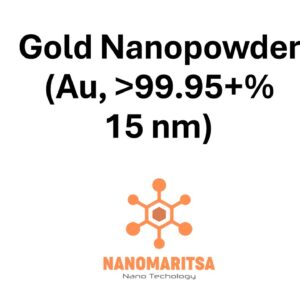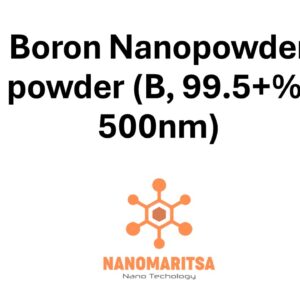Silver Nanopowder (Ag, 99.99%, 50-80 nm, metal basis) is a high-purity form of silver in the nanoparticle range, with particles sized between 50-80 nanometers (nm). It is typically used in various advanced applications where the unique properties of silver at the nanoscale are required. Below is a detailed breakdown of this material:
1. Key Features:
- Silver (Ag): The material is silver, which is well-known for its high electrical conductivity, thermal conductivity, antimicrobial properties, and catalytic activity. Silver in the nanoparticle form exhibits enhanced performance in these areas compared to bulk silver due to the increased surface area.
- Purity (99.99%): The 99.99% purity indicates that the silver nanopowder contains very little impurity, ensuring high-quality material for demanding applications.
- Nanoparticle Size (50-80 nm): The nanoparticles have a size range of 50-80 nm, which is a bit larger than some other silver nanopowders. This size range is typically chosen for applications requiring a balance between high surface area and practical usability in terms of dispersion and stability.
- Metal Basis: The metal basis refers to the content of actual silver in the nanopowder, giving the precise amount of silver present. This is important for ensuring that the material meets the specifications required for industrial or research purposes.
2. Properties:
- Increased Surface Area: The 50-80 nm size ensures a high surface-to-volume ratio, which increases the material’s reactivity compared to bulk silver. This makes it suitable for various applications, including catalysis, electrochemical processes, and antimicrobial use.
- Electrical Conductivity: As with all silver, this nanopowder retains its excellent electrical conductivity, which makes it valuable in applications such as conductive inks, printed electronics, and electronic components.
- Thermal Conductivity: Silver is also known for its high thermal conductivity, which is beneficial for heat dissipation applications, including electronics and thermal management materials.
- Antimicrobial Properties: Silver nanoparticles are widely used in antimicrobial applications, as they can inhibit the growth of bacteria and other microorganisms, making them ideal for use in medical devices, wound care products, and antibacterial coatings.
- Catalytic Activity: The increased surface area of these nanoparticles gives them enhanced catalytic activity, making them suitable for chemical reactions such as environmental remediation, fuel cells, and chemical synthesis.
3. Applications:
- Electronics: Due to the electrical conductivity of silver nanoparticles, they are commonly used in printed electronics, conductive inks, and other applications requiring materials with high conductivity for flexible circuits, sensors, and electronic devices.
- Medical and Antimicrobial Uses: The antimicrobial properties of silver nanoparticles make them useful in medical devices, such as wound dressings, catheters, and implants, where they can help prevent infections. Additionally, they are used in antibacterial coatings for textiles, medical equipment, and surfaces.
- Catalysis: These nanoparticles are used in catalytic processes, such as in the production of chemicals, environmental cleanup, and fuel cells. The high surface area allows for more efficient catalytic reactions.
- Sensors: Silver nanoparticles are used in sensors for detecting gases, chemicals, and biological agents. The nanoparticles’ high reactivity makes them ideal for interactions with target molecules in sensor technologies.
- Coatings and Materials: The nanoparticles are also incorporated into coatings to provide conductivity, antimicrobial effects, or other functional properties to a variety of materials.
4. Handling and Safety:
- Health and Safety Considerations: Silver nanoparticles can pose unique risks due to their small size and high reactivity. While silver itself is generally considered non-toxic in bulk form, nanoparticles can present hazards, such as inhalation or ingestion, which may lead to respiratory or other health issues. Proper handling, including the use of personal protective equipment (PPE) such as gloves, goggles, and face masks, is essential.
- Storage: Silver nanopowder should be stored in a cool, dry, and well-ventilated area to prevent oxidation or aggregation. The material should be stored in sealed containers to avoid exposure to moisture or contaminants.
- Precautions: It is advisable to handle silver nanopowder in a controlled environment, such as under a fume hood or in a lab with proper ventilation. Disposal of the material should be done according to safety guidelines to minimize environmental impact.
Summary:
Silver Nanopowder (Ag, 99.99%, 50-80 nm, metal basis) is a high-quality, high-purity form of silver nanoparticles with a size range of 50-80 nm. This nanopowder is used in a wide variety of applications where its excellent properties—such as electrical conductivity, thermal conductivity, antimicrobial effects, and catalytic activity—are beneficial. The high purity ensures optimal performance in sensitive applications, while the nanoparticle size offers enhanced reactivity and surface area. As with all nanomaterials, proper handling and safety precautions should be taken to ensure safe use and minimize potential health risks.
| Measurement (gr) | 5 grams, 25 grams, 100 grams |
|---|






